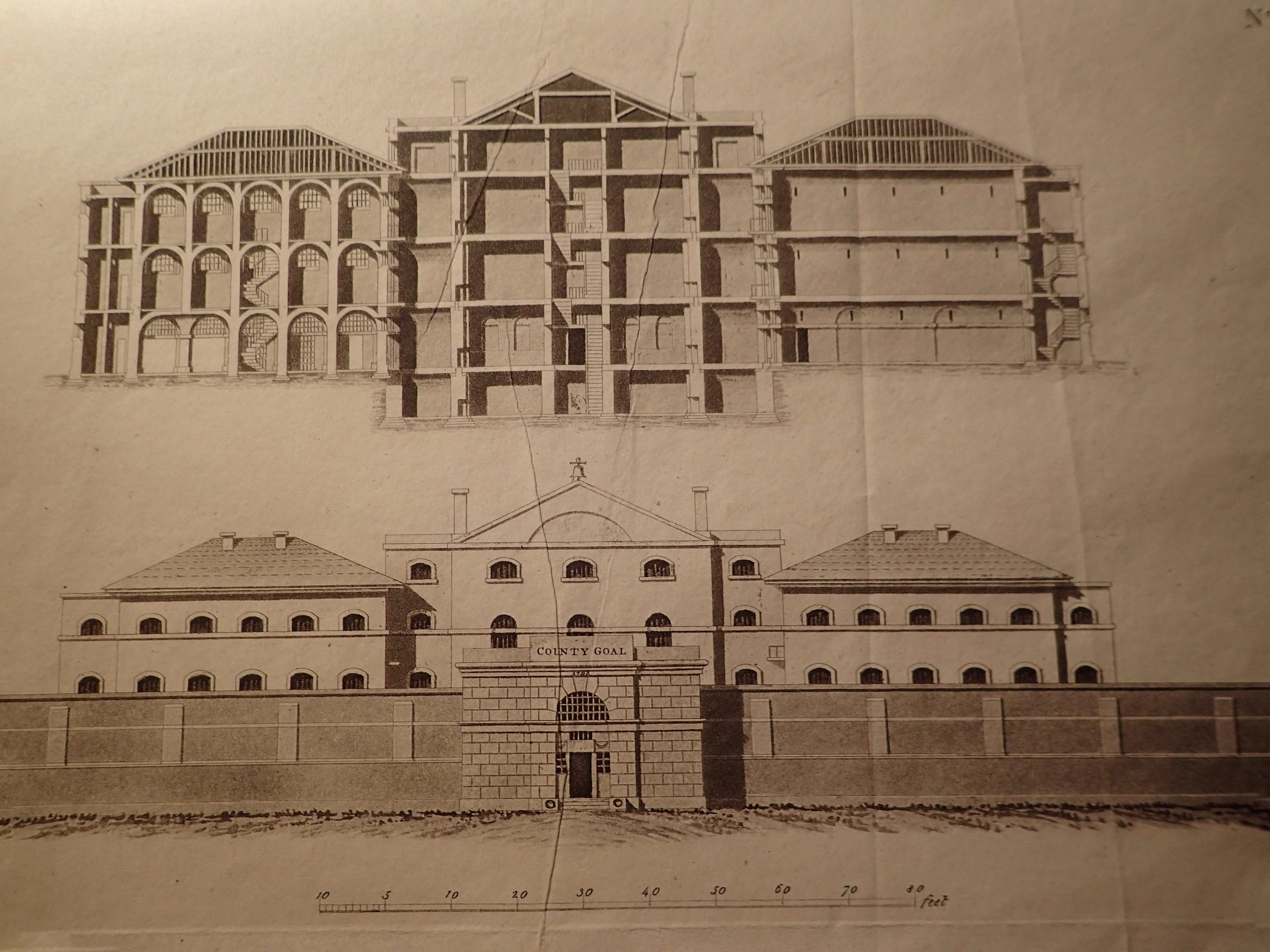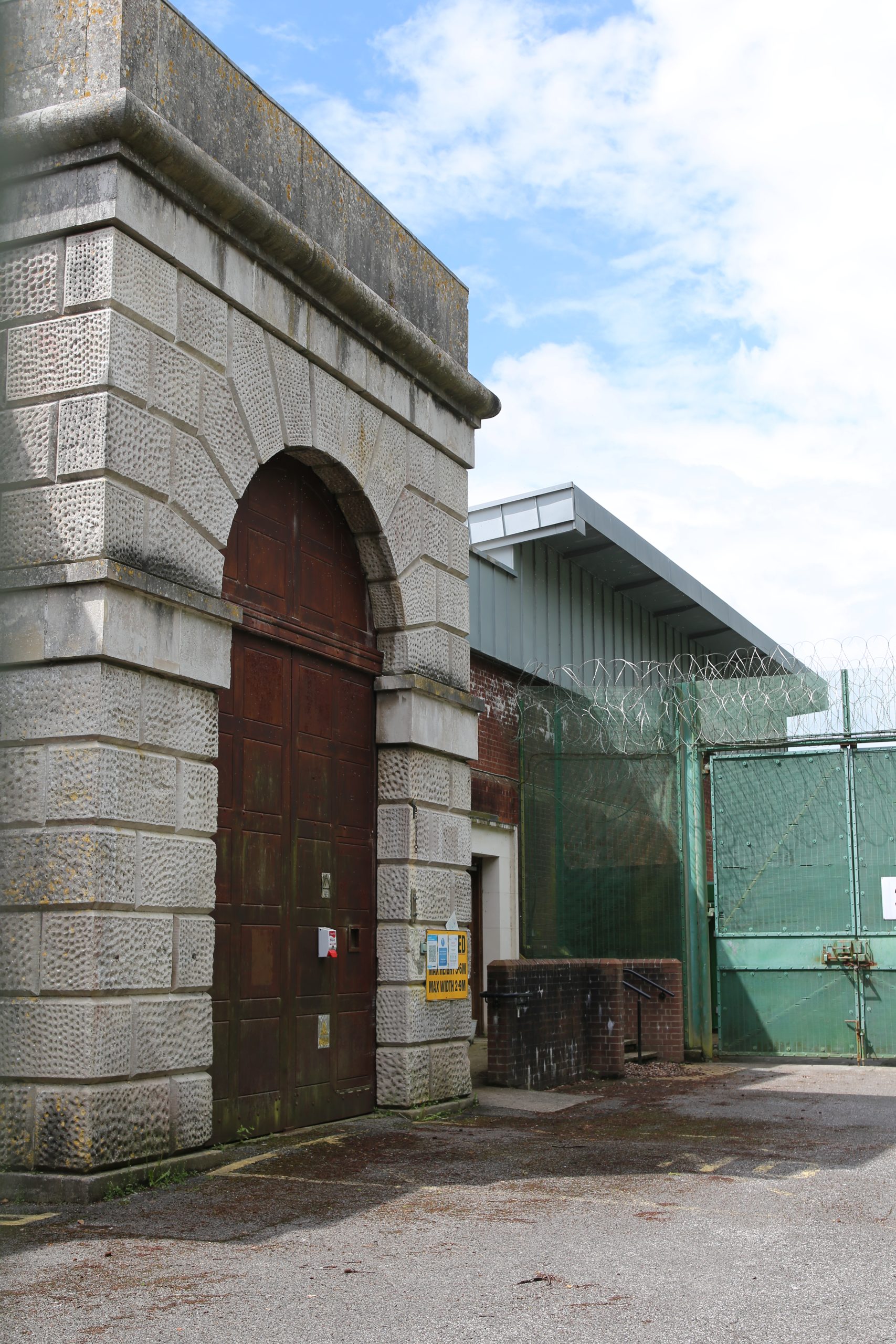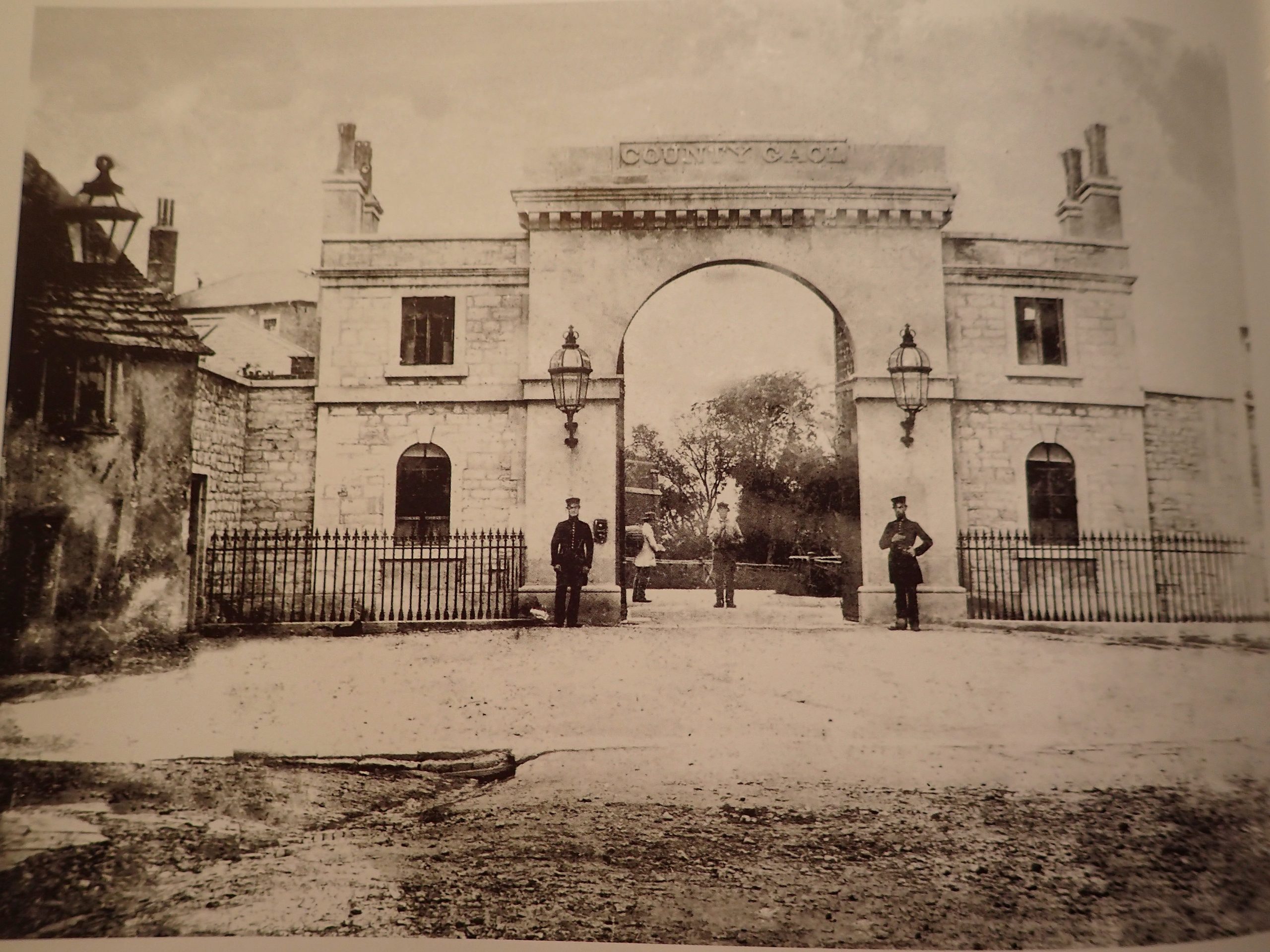DORCHESTER JAILS (by Ian Gosling)
The original gaol was said to be situated on the corner of Icen Way and High East Street, then called Gaol Lane, on a site which was rebuilt in the mid-18th century. It was close to Gallows Hill, at the other end of Gaol Lane, where those condemned to death were executed. It was opened after a receipt by the town of a grant of Letters Patent from Edward I in 1305.
In the 17th and 18th centuries the County Gaol was moved to a site at the eastern entry to the town, at the beginning of High East Street (Photo 1 of a print of 1795) where Eastgate House now stands. It housed prisoners awaiting trial at the Assizes or County Sessions together with debtors who had been committed at the request of their creditors and who were obliged to pay a daily rate for the cost of their own imprisonment! When the prison was rebuilt in 1628 the following doggerel verse was inscribed over the gate: “look in yourselves, this is the scope: Sin brings prison, prison the rope”. Debtors in the prison were visited by George III and the Royal family when they were on vacation in Weymouth and received financial assistance from them (Photo 2 of a print of 1793).
In 1787 the architect William Blackburn (1750-1790) was asked to report on the facilities and state of the prison at the bottom of High East Street. He was very influenced by the work of the prison reformer John Howard who himself said of Blackburn, “The ingenious Mr Blackburn… the only man capable of delineating what a prison should be”. John Howard had condemned the state of the old prison in Dorchester in the first edition of his book ‘The State of Prisons’ which he had published in 1777 and which argued for major reforms in the penal system. In particular it had disclosed that “smallpox was raging in the [Dorchester] prison, and producing sad havoc amongst the prisoners, and there was no infirmary to stop its progress”. The book argued for separation between males and females, and between serious and less serious offenders, increased levels of hygiene, more wholesome food, medical checks and generally for more humane conditions in prison.
In 1782, at the beginning of his career as an architect, William Blackburn had won first prize in a competition for the design of a model prison sponsored by the Commissioners for Penitentiary Houses who had been appointed under the Penitentiary Act of 1779. He had already designed and/or completed new prisons in Oxford, Ipswich, Gloucester and Monmouth.
Blackburn reported that the old prison should be replaced since it did not allow the solitude necessary for inmates to reflect on their past crimes and lacked ventilation and access to outside recreation areas. As a result, he was commissioned in 1788 to design a bigger and more commodious replacement which comprised a central administrative block with four wings to house the residents (Photo 3 of the architectural design of the main façade).
Work on the new prison was commenced in 1789 on the site of the old moat and bailey Norman castle. It was completed by 1794 and is said to have cost £ 16,179. 10s 6d. In his ‘History of Dorchester’ of 1833 James Savage describes the layout of the New County Gaol as follows:
“This edifice, in its external appearance, is peculiarly handsome and characteristic; and the interior possesses every convenience necessary for its destination. The building consists of a lodge, keeper’s house, chapel, debtors’ day room, female fines [cells], and female debtors’ rooms, visiting rooms for male debtors, fines, felons’ infirmaries, and &c., and of four wings, detached from, but communicating with, the centre building on each story, by means of cast-iron bridges from the several galleries. There are separate sleeping cells for eighty-eight prisoners, which are distributed in several buildings; and two airy dormitories for male debtors, each containing four beds, to be used in case the number exceeds that which can be accommodated in the debtors’ wing; besides four cells for condemned prisoners, light and airy; four over these perfectly dark, yet airy, for the refractory; and six reception cells, which last are fitted out in the lodge. The distribution is such, that not only the male prisoners are separated from the female, and the felons from the debtors, fines &c., but those of each description are subdivided into classes; and for each class, by means of distinct staircases, separate subdivisions are appropriated, with courts, working rooms &c. to each. The female fines, and the female debtors, have each a commodious room, with every possible convenience; over the male debtors’ dormitories, and under the two infirmaries, separate and detached from every part of the building, except for the keeper’s house and court, to which they have access through the chapel.”
He graphically describes the procedure on admittance of new prisoners:
“In the reception cells, in the lodge, prisoners are placed immediately on their entrance, until they can be examined by the surgeon, and thoroughly cleaned, for which purpose here are a hot and cold bath. If in a foul or infectious state, they remain there until the surgeon pronounces them fit to be removed to the interior parts of the prison. They are then sent to their proper classes; and all felons are apparelled in the gaol uniform; and their own clothes, if they are fit to be preserved, are fumigated in a kiln, and laid in the wardrobe until their liberation, or are delivered to the care of their friends.”
The administrative and practical aspects of running the prison are commented upon:
“There are also two rooms in the lodge, for the habitation of the task-master, and a small one for one of the turnkeys; a wardrobe; a room containing one of the Stockdale’s Mills for grinding corn [the then state of the art milling equipment] , and every other requisite for grinding and for dressing the flour, for where all the corn used for supplying the prison is ground, and which is found to answer extremely well; a committee room for the magistrates to transact business in; an office for the Governor of the gaol; a bakehouse and brewhouse [Water in those days could be contaminated] , with iron boilers, an oven, and other conveniences for cooking for the prisoners;”
And for an unfortunate few:
“…on the top of the lodge there is a flat roof covered with copper on which executions take place in view of all the criminal prisoners.”
This new prison was in turn replaced by the present building which was competed in 1886.
the only remaining feature of Blackburn’s prison are parts of the surrounding walls and the gatehouse, which originally stood in front of the central Gaol lodge and was moved from its original location on the south of the site to its present position at the north entrance to the prison buildings after having been extensively remodelled. The result is seen in Photo 4.
An additional exterior gateway which existed on North Square when Photo 5 was taken in 1856 no longer exists. Various additions and modifications to the Victorian building were made during the 20th century until the prison was closed in January 2014.
City and Country, the present owner of the site, obtained planning permission in 2016 to transform the main Victorian buildings into 190 apartments but the project, which has been modified since that date to increase the number of dwellings proposed, has remained frozen, apparently by a lack of funding.






Recent Comments